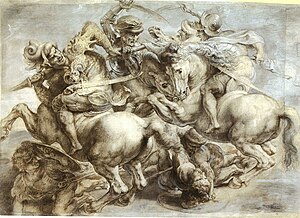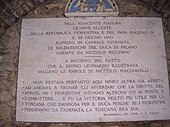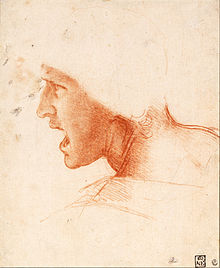
Condottieri were Italian captains in command of mercenary companies during the Middle Ages and of multinational armies during the early modern period. They notably served popes and other European monarchs during the Italian Wars of the Renaissance and the European Wars of Religion. Notable condottieri include Prospero Colonna, Giovanni dalle Bande Nere, Cesare Borgia, the Marquis of Pescara, Andrea Doria, and the Duke of Parma.

Sir John Hawkwood was an English soldier who served as a mercenary leader or condottiero in Italy. As his name was difficult to pronounce for non-English-speaking contemporaries, there are many variations of it in the historical record. He often referred to himself as Haukevvod and in Italy, he was known as Giovanni Acuto, literally meaning "John Sharp" in reference to his "cleverness or cunning". His name was Latinised as Johannes Acutus. Other recorded forms are Aucgunctur, Haughd, Hauvod, Hankelvode, Augudh, Auchevud, Haukwode and Haucod. His exploits made him a man shrouded in myth in both England and Italy. Much of his enduring fame results from the surviving large and prominent fresco portrait of him in the Duomo, Florence, made in 1436 by Paolo Uccello, seen every year by 4½ million tourists.

Niccolò Piccinino was an Italian condottiero.

The Battle of San Romano was fought on 1 June 1432, in San Romano, some 30 miles outside Florence, between the troops of Florence, commanded by Niccolò da Tolentino, and Siena, under Francesco Piccinino. The outcome is generally considered favourable to the Florentines, but in the Sienese chronicles it was considered a victory. As the 1430s began Florence had found itself in conflict with the rival city state of Lucca, and her allies, Siena and Milan.

The Wars in Lombardy were a series of conflicts between the Republic of Venice and the Duchy of Milan and their respective allies, fought in four campaigns in a struggle for hegemony in Northern Italy that ravaged the economy of Lombardy. They lasted from 1423 until the signing of the Treaty of Lodi in 1454. During their course, the political structure of Italy was transformed: out of a competitive congeries of communes and city-states emerged the five major Italian territorial powers that would make up the map of Italy for the remainder of the 15th century and the beginning of the Italian Wars at the turn of the 16th century. They were Venice, Milan, Florence, the Papal States and Naples. Important cultural centers of Tuscany and Northern Italy—Siena, Pisa, Urbino, Mantua, Ferrara—became politically marginalized.

The Battle of Anghiari (1505) was a planned painting by Leonardo da Vinci in the Salone dei Cinquecento in the Palazzo Vecchio, Florence. Its central scene would have depicted four men riding raging war horses engaged in a struggle for possession of a standard at the Battle of Anghiari in 1440.
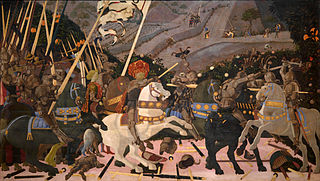
The Battle of San Romano is a set of three paintings by the Florentine painter Paolo Uccello depicting events that took place at the Battle of San Romano between Florentine and Sienese forces in 1432. They are significant as revealing the development of linear perspective in early Italian Renaissance painting, and are unusual as a major secular commission. The paintings are in egg tempera on wooden panels, each over 3 metres long. According to the National Gallery, the panels were commissioned by a member of the Bartolini Salimbeni family in Florence sometime between 1435 and 1460. The paintings were much admired in the 15th century; Lorenzo de' Medici so coveted them that he purchased one and had the remaining two forcibly removed to the Palazzo Medici. They are now divided between three collections, the National Gallery, London, the Galleria degli Uffizi, Florence, and the Musée du Louvre, Paris.
The Battle of Zagonara was fought on 28 July 1424 at Zagonara between the armies of the Republic of Florence and that of Filippo Maria Visconti, duke of Milan, an episode of the Wars in Lombardy. A number of famous Italian condottieri of the 15th century took part in the battle. The only condottiero who died in the battle was Lodovico degli Obizzi, who fell off his horse and suffocated in the mud.

The Battle on the Po was a battle of the Wars in Lombardy. It occurred in June 1431, on the Po River, near Cremona. The battle was fought between 85 Venetian galleys, sent towards Cremona to support Count of Carmagnola's army, and a somewhat superior number of Milanese galleys. The Venetians were commanded by Niccolò Trevisani.

Niccolò Mauruzzi, best known as Niccolò da Tolentino was an Italian condottiero.

Micheletto Attendolo, also called Micheletto da Cotignola, was an Italian condottiero. He was seigneur of Acquapendente, Potenza, Alianello, Castelfranco Veneto and Pozzolo Formigaro.

The Funerary Monumentto SirJohn Hawkwood is a fresco by Paolo Uccello, commemorating English condottiero John Hawkwood, commissioned in 1436 for Florence Cathedral. The fresco is an important example of art commemorating a soldier-for-hire who fought in the Italian peninsula and is a seminal work in the development of perspective.
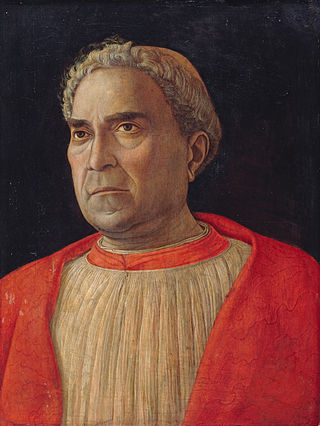
Ludovico Trevisan was an Italian catholic prelate, who was the Camerlengo of the Holy Roman Church, Patriarch of Aquileia and Captain General of the Church. He succeeded his rival Giovanni Vitelleschi, a fellow cardinal of military talent and inclination, as Bishop of Traù and Metropolitan Archbishop of Florence. Trevisan was also known as the Cardinal of Aquileia and the Cardinal Camerlengo.

Francesco Piccinino was an Italian condottiero.

The Battle of Cascina is a never-completed painting in fresco commissioned from Michelangelo for the Palazzo Vecchio in Florence. He created only the preparatory drawing before being called to Rome by Pope Julius II, where he worked on the Pope's tomb; before completing this project, he returned to Florence for some months to complete the cartoon.

The Battle of Cascina was an engagement between Pisan and Florentine troops on 28 July 1364 near Cascina, modern-day Italy. Florence's victory followed a recent defeat to Pisan forces that had enabled mercenary John Hawkwood, who was in command of the Pisan army, to occupy the Valdinievole, Prato en route to Florence. Hawkwood and his army looted the lucrative Mugello region and Pistoia before proceeding towards Florence. Hawkwood fought alongside Hanneken von Baumgarten and had 3,000 men-at-arms at his disposal.
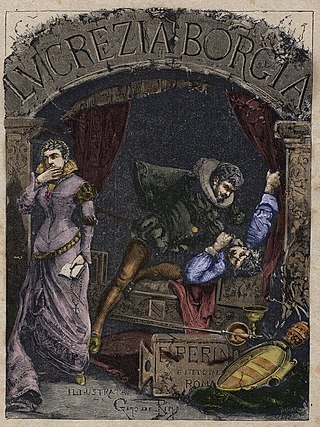
Micheletto Corella was a Valencian condottiero born on an unknown date in Valencia. He was killed in Milan in February 1508.
The military reforms of the Florentine Republic were initiated by Florentine politician and political theorist Niccolò Machiavelli during the short-lived Republic of Florence that lasted from 1498 to 1512 under the priest Girolamo Savonarola. In the pursuit of the republican spirit which pervaded Florence at the time, Machiavelli sought to establish a military establishment that was similar to that of ancient Rome. He was specifically focused upon the establishment of an army possessed with the discipline of the Roman legions. He sought to establish a citizen-infantry capable of taking the field against the Italian Condottieri of the day, who largely terrorized the peninsula, in addition to the chronic foreign invasions which occurred on a regular basis at this time. Broadly speaking Machiavelli would institute a series of reforms in 1506 that would create a citizen army of 20,000 men, and establish a system that would keep this citizen army in a state of readiness.
Jacopo Piccinino was an Italian condottiero and nobleman, the son of military leader Niccolò Piccinino. A native of Perugia, he was the feudal lord of Sulmona, Sterpeto, Assisi, Chieti, Città Sant'Angelo, Francavilla al Mare, Varzi, Fiorenzuola d'Arda, Atessa, Fidenza, Pandino, Penne, Borgonovo Val Tidone, Castell'Arquato, Frugarolo, Borgo Val di Taro.
